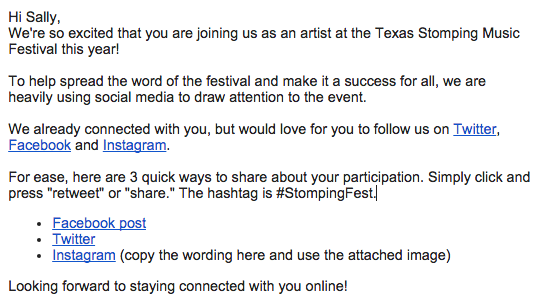4 Things You Should Absolutely Be Doing on Social Media Before Your Event Starts
 The biggest rookie mistake in social media for events is that the brand waits to begin social media postings (or doesn’t post often) until the event is almost there.
The biggest rookie mistake in social media for events is that the brand waits to begin social media postings (or doesn’t post often) until the event is almost there.
Social media has significant value for search engine optimization, it keeps your brand top of mind for festival goers, and begins building an audience that you can continuously market to. So, if you have an event in the next 6 months, stop reading this now and go set up your social accounts.
Here are 4 things you absolutely should be doing on social media way before you event starts:
1. Determine a hashtag to use it wisely:
Create a hashtag that is short, easy to remember, and looks good when you put the words together in all lowercase. Twitter doesn’t distinguish between cases in searches, for example: #musiccreation vs #MusicCreation will return the same search results, but when it’s written using lowercase letters, it’s difficult to read. You won’t be able to control how people use it. Be sure to test out your hashtag and make sure it’s not overly utilized elsewhere – especially in a negative way. Then make sure your partners, artists, sponsors, etc. know what it is.

TIP: Not sure what a hashtag is? Start here or email us at Pigtail Media so we can discuss how it can be best used for your brand.
2. Tease your event (and use your hashtag):
With each announcement you have, use social media to update your audience and keep your festival top of mind. It’s a no brainer for the big stuff, but keep in mind the small stuff can still create a story.
You may think each announcement isn’t all that exciting. But it gives people a chance to get to know your brand, see it come to fruition, trust your brand, and follow along in your excitement. Finish your logo? Signed your first artist? Posters were just pressed? Your blog is live? Batch of tickets sent? Share it.
Tip: Don’t go overboard on Facebook posts. 1 post a day is sufficient and make it really good. Twitter is much more acceptable to post 5+ tweets a day, but make sure each tweet is not all about your event.
3. Let your partners know your event is on social media:
Email your sponsors, partners, artists, etc. with an overview about your social sites. Provide them with your hashtag, your social links, and simple messages they can share on Twitter, Instagram and Facebook that benefit your event.
Tip: The easier you make it for them, the more likely they will follow and share your event news.
4. Use Twitter to build influencer relationships – and take it outside of social.
Through Twitter, you can search, follow and put users into specific lists. Those lists can then be viewed independently of all the other accounts you follow. Think about it as a tool to clear out the clutter and only see the posts from the people who matter most to you.
For example, identify the media outlets that are fitting to your press and outreach strategy. See who the writers are and do your diligence and search for them on Twitter. Follow, engage 1-3 times with their content to put you on their radar and then compartmentalize them into your LIST of media.
Utilize this list in two ways: 1) Episodically visit that list and engage with the content to keep yourself top of mind. Don’t be afraid to tweet that person when there’s something you want to share, just don’t tweet the same message to multiple media outlets/writers at once. That’s visible for all to see and removes any personalization. 2) If you DON’T have a PR Team, consider digging deeper and finding the email address of this person. Introduce yourself via email in an authentic way – where you aren’t selling anything. Keep those emails contacts is a safe place. When you have a press release or announcement, those can be your source of press mentions.
Tip: One effective and efficient way to find a writer on Twitter is simply put in their name + “twitter” into a google search. Additionally, searching Twitter.com with the media’s twitter handle name. Many writers will include that in their bio.
Social media does take time, but give it the time that it deserves because it can easily become the leading referral source on your website, an “in” to media contacts and bloggers, and the biggest way to connect with an audience and have them fall in love with your event … before it even happens.

 And that is it. Some people like to do the reverse and say “Kara for Mike” instead of “Mike for Kara”, but I prefer the latter. Either way works fine, but it can be confusing at first so it’s best the entire event team stays consistent – pick one method or the other.
And that is it. Some people like to do the reverse and say “Kara for Mike” instead of “Mike for Kara”, but I prefer the latter. Either way works fine, but it can be confusing at first so it’s best the entire event team stays consistent – pick one method or the other.